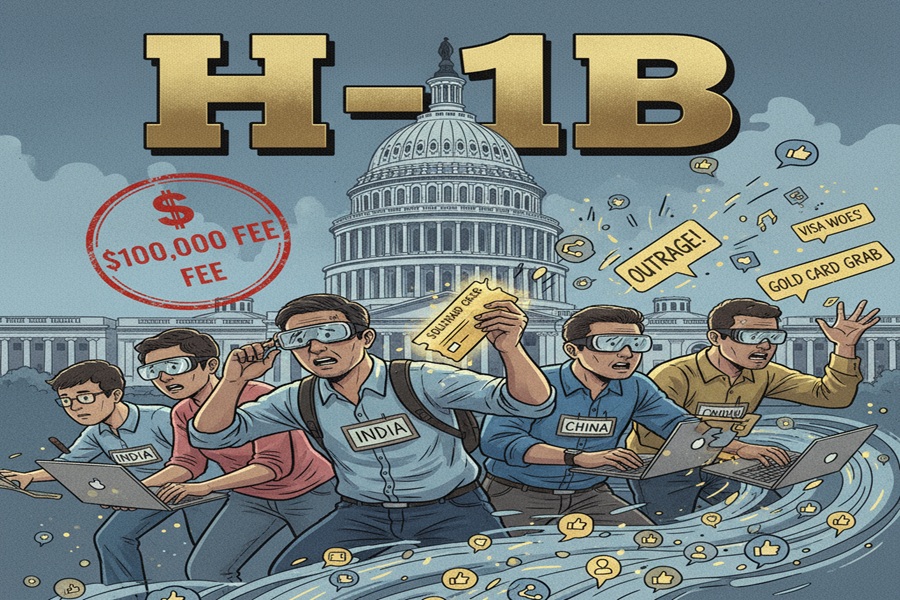Washington, D.C. — September 20, 2025 — The U.S. has just seen a dramatic overhaul of its H-1B visa policy that is rippling across the tech industry, global talent markets, and immigration debates. Following recent announcements, “H-1B” is trending sharply on X, with thousands of posts reacting to new fees, wage-rule changes, and what these might mean for foreign professionals, especially from India and China.
What Was Announced
- President Donald Trump has signed a presidential proclamation requiring that every H-1B visa petition be accompanied by a $100,000 annual fee.
- The fee applies to both new applications and renewals.
- There are accompanying changes to wage rules: the Secretary of Labor has been directed to revise prevailing-wage levels so they are higher, to ensure that foreign workers are not undercutting U.S. workers.
- A restriction on entry is included for those not paying the fee: for petitions filed by foreign nationals outside the U.S., the entry into U.S. will be restricted if the payment is not made. This restriction starts September 21, 2025 and will last 12 months, unless extended.
- There is also a “Gold Card” visa program announced: a separate pathway for wealthy or “extraordinary ability” applicants, with a $1 million payment (corporate sponsorship doubles that) that could expedite or possibly give permanent residency.
Why It’s Causing a Stir
- Massive Cost Increase
The previous fees for H-1B petitions were a few thousand dollars (depending on employer size, processing, etc.). Suddenly mandating six- or even three-figure fees per year represents an enormous jump. For many companies—especially tech firms that hire dozens or hundreds of H-1B workers—this could mean hundreds of millions in new costs. - Impact on Indian Tech & Workers
India currently accounts for the largest share of H-1B beneficiaries (~70%) in recent years.
The cost jump will disproportionately affect employees and companies tied to Indian talent. Indian IT firms often rely heavily on H-1B visas to send staff to U.S. projects. The increased cost could reduce opportunities, shift hiring to domestic U.S. workers, or push companies to move operations elsewhere. - Criticism from Industry, Legal Questions
Some tech leaders and immigration advocates argue that the fee is so high it will essentially price out many applicants and could hurt innovation. There are concerns about the legality of imposing such fees through a proclamation rather than through Congress or a formal rulemaking process. - Policy Goals & Politics
The administration frames this as protecting American workers from wage suppression and ensuring that H-1B visas are granted only for high-value, essential skillsets. It also aligns with broader immigration tightening and prioritization of domestic hiring. - Uncertainty and Transition Periods
The policy has time-sensitive components. For example, some restrictions begin from September 21, 2025, and extend for 12 months. The exact implementation details (how prevailing wages will be calculated, how the fee is enforced, exceptions) are being worked out. That creates ambiguity, which tends to generate a lot of discussion on social media.
What This Means for the Future
- For Foreign Professionals: Those hoping to get or renew an H-1B visa will need to see whether their employer is willing to bear this cost. Some may opt for other visas; others may consider staying outside the U.S. or choosing different countries.
- For Companies: Big tech and mid-sized firms will have to adjust budgets, hiring plans, and possibly move work offshore or rely more on remote employees.
- For U.S. Workforce & Job Market: There may be fewer foreign workers coming in under H-1B, particularly for lower-wage levels. This could relieve some pressure on wages, but also risk talent shortages in high‐tech, engineering, research fields where domestic supply isn’t enough.
- Legal/Legislative Pushback: The changes will likely lead to lawsuits or congressional action. Immigration law, employer responsibilities, and constitutional questions are going to be central in those disputes.
Bottom Line
What started as a policy tweak has turned into one of the most sweeping changes to the U.S. skilled worker visa landscape in decades. The $100,000 fee per H-1B visa petition (plus other wage rule changes) isn’t just an administrative update—it signals a shift in how the U.S. views foreign talent: more as a premium, less as a mass category. The reverberations—legal, economic, and humanitarian—are only starting.
https://twitter.com/EricLDaugh/status/1969154688009318712
Sources:
AP News; Reuters; The Guardian; Al Jazeera; Times of India; Economic Times; Washington Post (AP News)
